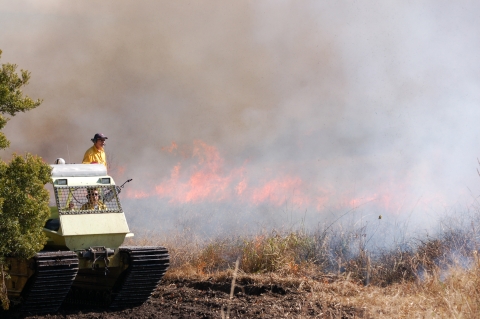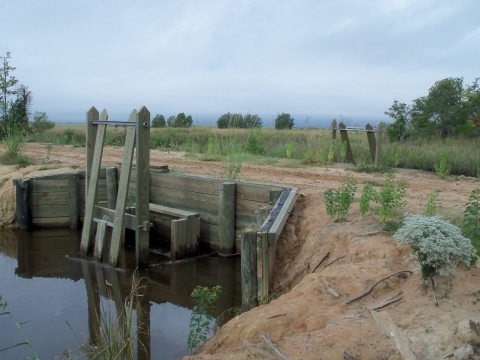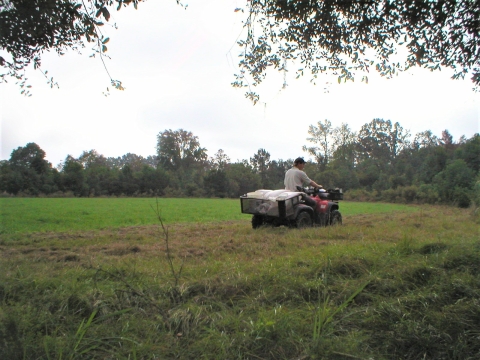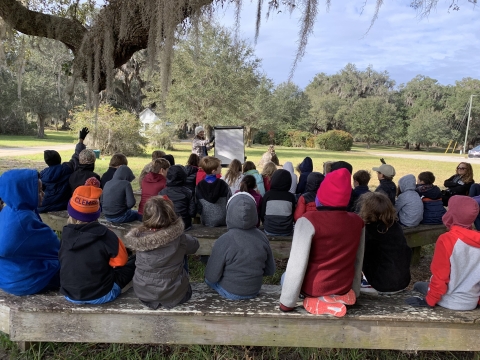What We Do
Wildlife conservation is at the heart of the National Wildlife Refuge System. It drives everything on U.S. Fish and Wildlife Service lands and waters managed within the Refuge System, from the purposes for which a national wildlife refuge national wildlife refuge
A national wildlife refuge is typically a contiguous area of land and water managed by the U.S. Fish and Wildlife Service for the conservation and, where appropriate, restoration of fish, wildlife and plant resources and their habitats for the benefit of present and future generations of Americans.
Learn more about national wildlife refuge is established to the recreational activities offered to the resource management tools used. Using conservation best practices, the Refuge System manages Service lands and waters to help ensure the survival of native wildlife species.
E.F.H. ACE Basin NWR manages its intricate network of marshes, tidal creeks, forested uplands and wetlands, fields, wetlands and impoundments to support the myriad of plants and wildlife.
Committed to preserving the natural resources to assure that all habitats and wildlife continue to thrive, conservation management employs a variety of techniques. These include moist soil management that utilizes structures to control tidal flow into impoundments, prescribed fire for removal of unwanted vegetation and ground litter, and agricultural planting and disking in fields to encourage diversity and wildlife movement. Forest management may include tree thinning, creating edge zones, and planting shrubs and trees. Trapping may be employed to protect endangered and threatened species and migratory birds or to control populations.
Wholesome wildlife-dependent activities are offered that are compatible with refuge objectives for wildlife and habitats. Hunting is a tool used to manage for healthy wildlife populations and habitats and a traditional outdoor pastime. Deer, feral hog and waterfowl hunts are scheduled annually. Fishing is allowed on specific areas of the refuge. Hunting and fishing activities are in accordance with state regulations and the specific refuge regulations.
Management and Conservation
Refuges deploy a host of scientifically sound management tools to address biological challenges. These tools span active water management to wilderness character monitoring, all aimed at ensuring a balanced conservation approach to benefit both wildlife and people. At this field station our conservation tool box includes:
Planning – The Ernest F. Hollings ACE Basin NWR Comprehensive Conservation Plan (CCP) describes the role the refuge will play in support of the mission of the Refuge System. Direction and implementation include foremost habitat and fish and wildlife conservation, with wildlife-dependent recreation allowed and encouraged while compatible with the purposes of the refuge.
Habitat Restoration– Moist soil management is used to control water levels to promote wetland plant growth and support small fish, crustaceans and insects by mimicking wet and dry season cycles. Structures known as rice trunks control water flow between tidal creeks or rivers and managed wetland impoundments. These managed wetland units support a myriad of wildlife species such as waterfowl, bald eagles, alligators, wood storks, wading birds and numerous other species.
Agriculture – The refuge plants approximately 10 acres of field with a winter wheat mix to meet foraging needs of geese and other waterfowl during winter months.
Fire Management - Prescribed burning is used in impoundments, forested upland areas and abandoned fields to remove undesirable vegetation and produce seed crops, grasses and other food sources for deer, turkey and other bird species. Mechanical disking in fields is practiced to control overgrowth and enhance wildlife movement and habitat diversity.
Invasive Species – The refuge impoundments are managed to control phragmities and in the more upland areas, measures are taken to control the Chinese tallow. Mechanical and applied applications are used to manage these invasive species invasive species
An invasive species is any plant or animal that has spread or been introduced into a new area where they are, or could, cause harm to the environment, economy, or human, animal, or plant health. Their unwelcome presence can destroy ecosystems and cost millions of dollars.
Learn more about invasive species .
Feral hogs destroy habitat and compete with native wildlife for food sources. Trapping and annual hunts on the refuge are utilized to control the feral hog population.
Trapping – Trapping of other nuisance animals is employed to control excessive depredation of native wildlife and to prevent habitat destruction. Nuisance animals compete for food sources and negatively alter wetlands and landscape transition areas.
Cultural Resources – The headquarters or, Grove Plantation House, was listed on the National Register of Historic Places by former owners to ensure its protection and preservation. Any repairs and maintenance on the house are done in accordance with Register-listed historic properties. On-going stabilization work continues on the historic overseer’s house on Jehossee Island with other archeological sites preserved. The refuge restricts public access to Jehossee Island and offers limited tours to small research and university groups.
Recreation Management: Hunting
Hunting is an important management tool to control and promote healthy wildlife populations while offering a healthy, traditional outdoor pastime. Deer and waterfowl hunts are scheduled annually in accordance with state and federal regulations. Feral pigs destroy native habitat, compete with native species for food sources, consume native wildlife and are considered a nuisance animal. The refuge offers feral hog hunts only during the deer hunts and in accordance with state and federal regulations.
Recreation Management: Fishing
The ACE Basin estuarine system provides habitat and as a spawning and nursery ground for anadromous fish as well as other important species including the largemouth bass, crappie, catfish, and bream. Walk-in bank fishing with hook and line is allowed in refuge impoundments, canals and river access locations during the time period of April through August.
Education – Education programs for local grade schools are conducted, in concert, with the Friends of Coastal South Carolina. Partnerships with historical associations, resource agencies and organizations, and colleges provide opportunities for environmental studies and special tours on the refuge.
Our Services
ACE Basin NWR, within the Ashepoo-Combahee-Edisto (ACE) system, is an exceptionally rich and diverse ecosystem that supports a myriad of both plant and wildlife species. The refuge offers unique opportunities for research, education internships and outdoor recreation pursuits when activities are compatible with the refuge purpose and objectives.
Law Enforcement
Federal Wildlife Officers patrol refuge properties to protect our public resources. Officers work closely with local, state, and federal agencies to protect wildlife and habitat, and to ensure public safety on the refuge. Officers also enforce hunting, fishing and safety regulations, the Migratory Bird Treaty Act and other wildlife laws.
Laws and Regulations
Administration of national wildlife refuges is guided by the mission and goals of the Refuge System, congressional legislation, presidential executive orders, and international treaties. Policies for management options of refuges are further refined by administrative guidelines established by the Secretary of the Interior and by policy guidelines established by the Director of the Fish and Wildlife Service. There are a selected number of legal treaties and laws that are relevant to the management of E.F.H. ACE Basin NWR.









